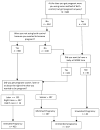Pregnancy intention and postpartum depression: secondary data analysis from a prospective cohort
- PMID: 23651010
- PMCID: PMC3708972
- DOI: 10.1111/1471-0528.12255
Pregnancy intention and postpartum depression: secondary data analysis from a prospective cohort
Abstract
Objective: To assess the relationship between unintended pregnancy and postpartum depression.
Design: Secondary analysis of data from a prospective pregnancy cohort.
Setting: The study was performed at the University of North Carolina prenatal care clinics.
Population/sample: Pregnant women enrolled for prenatal care at the University of North Carolina Hospital Center.
Methods: Participants were questioned about pregnancy intention at 15-19 weeks of gestation, and classified as having an intended, mistimed or unwanted pregnancy. They were evaluated for postpartum depression at 3 and 12 months postpartum. Log binomial regression was used to assess the relationship between unintended pregnancy and depression, controlling for confounding by demographic factors and reproductive history.
Main outcome measures: Depression at 3 and 12 months postpartum, defined as Edinburgh Postpartum Depression Scale score >13.
Results: Data were analysed for 688 women at 3 months and 550 women at 12 months. Depression was more likely in women with unintended pregnancies at both 3 months (risk ratio [RR] 2.1, 95% confidence interval [95% CI] 1.2-3.6) and 12 months (RR 3.6, 95% CI 1.8-7.1). Using multivariable analysis adjusting for confounding by age, poverty and education level, women with unintended pregnancies were twice as likely to have postpartum depression at 12 months (RR 2.0, 95% CI 0.96-4.0).
Conclusion: While many elements may contribute to postpartum depression, unintended pregnancy could also be a contributing factor. Women with unintended pregnancy may have an increased risk of depression up to 1 year postpartum.
Keywords: Depression; pregnancy intention; unwanted pregnancy.
© 2013 The Authors BJOG An International Journal of Obstetrics and Gynaecology © 2013 RCOG.
Conflict of interest statement
Figures
Comment in
-
Commentary on 'Pregnancy intention and postpartum depression: secondary data analysis from a prospective cohort'.BJOG. 2013 Aug;120(9):1122. BJOG. 2013. PMID: 24000409 No abstract available.
Similar articles
-
Unintended pregnancy and postpartum depression among first-time mothers.J Womens Health (Larchmt). 2013 May;22(5):412-6. doi: 10.1089/jwh.2012.3926. Epub 2013 Mar 14. J Womens Health (Larchmt). 2013. PMID: 23488527 Free PMC article.
-
Unintended pregnancy and associated maternal preconception, prenatal and postpartum behaviors.Contraception. 2009 Mar;79(3):194-8. doi: 10.1016/j.contraception.2008.09.009. Epub 2008 Oct 30. Contraception. 2009. PMID: 19185672
-
Unintended pregnancy is a risk factor for depressive symptoms among socio-economically disadvantaged women in rural Bangladesh.BMC Pregnancy Childbirth. 2018 Dec 13;18(1):490. doi: 10.1186/s12884-018-2097-2. BMC Pregnancy Childbirth. 2018. PMID: 30545325 Free PMC article.
-
Is unintended pregnancy a risk factor for depression in Iranian women?East Mediterr Health J. 2005 Jul;11(4):618-24. East Mediterr Health J. 2005. PMID: 16700376
-
Unintended pregnancy and postpartum depression: A meta-analysis of cohort and case-control studies.J Psychosom Res. 2020 Nov;138:110259. doi: 10.1016/j.jpsychores.2020.110259. Epub 2020 Sep 23. J Psychosom Res. 2020. PMID: 33002811 Review.
Cited by
-
Does childbirth cause psychiatric disorders? A population-based study paralleling a natural experiment.Epidemiology. 2015 Jan;26(1):79-84. doi: 10.1097/EDE.0000000000000193. Epidemiology. 2015. PMID: 25322321 Free PMC article.
-
Factors associated with postpartum depression among women in Vientiane Capital, Lao People's Democratic Republic: A cross-sectional study.PLoS One. 2020 Dec 4;15(12):e0243463. doi: 10.1371/journal.pone.0243463. eCollection 2020. PLoS One. 2020. PMID: 33275620 Free PMC article.
-
Maternal opioid drug use during pregnancy and its impact on perinatal morbidity, mortality, and the costs of medical care in the United States.J Pregnancy. 2014;2014:906723. doi: 10.1155/2014/906723. Epub 2014 Aug 28. J Pregnancy. 2014. PMID: 25254116 Free PMC article.
-
Economic and Health Predictors of National Postpartum Depression Prevalence: A Systematic Review, Meta-analysis, and Meta-Regression of 291 Studies from 56 Countries.Front Psychiatry. 2018 Feb 1;8:248. doi: 10.3389/fpsyt.2017.00248. eCollection 2017. Front Psychiatry. 2018. PMID: 29449816 Free PMC article.
-
Gender differences in depression in representative national samples: Meta-analyses of diagnoses and symptoms.Psychol Bull. 2017 Aug;143(8):783-822. doi: 10.1037/bul0000102. Epub 2017 Apr 27. Psychol Bull. 2017. PMID: 28447828 Free PMC article.
References
-
- Cheng D, Schwarz EB, Douglas E, Horon I. Unintended pregnancy and associated maternal preconception, prenatal and postpartum behaviors. Contraception. 2009;79:194–8. - PubMed
-
- Shah PS, Balkhair T, Ohlsson A, Beyene J, Scott F, Frick C. Intention to become pregnant and low birth weight and preterm birth: a systematic review. Matern Child Health J. 2011;15:205–16. - PubMed
-
- David H. Born Unwanted, 35 Years Later: The Prague Study. Reproductive Health Matters. 2006;14:181–190. - PubMed
-
- Messer LC, Dole N, Kaufman JS, Savitz DA. Pregnancy intendedness, maternal psychosocial factors and preterm birth. Matern Child Health J. 2005;9:403–12. - PubMed
Publication types
MeSH terms
Grants and funding
LinkOut - more resources
Full Text Sources
Other Literature Sources
Medical



